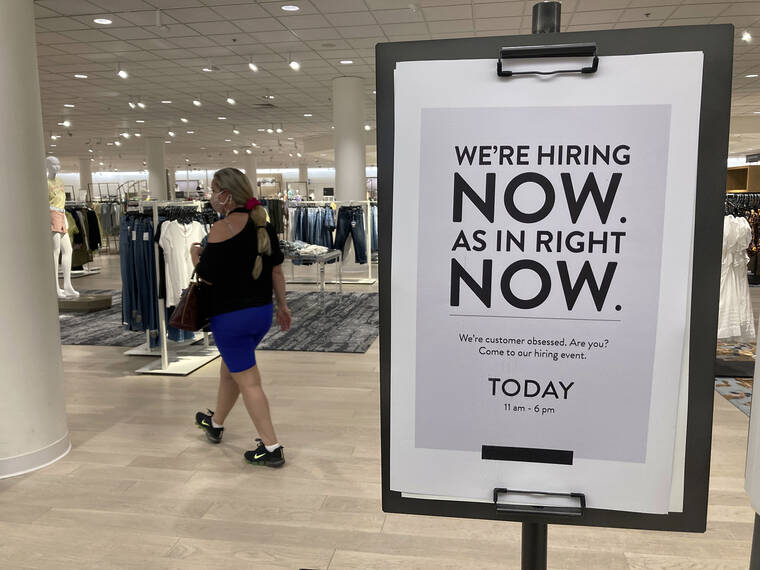Delta variant and worker shortage keep a lid on job growth

In this May 21 file photo, a customer walks behind a sign at a Nordstrom store seeking employees in Coral Gables, Fla. (AP Photo/Marta Lavandier, File)
WASHINGTON — U.S. employers added just 194,000 jobs in September, a second straight tepid gain and evidence that the pandemic has kept its grip on the economy, with many companies struggling to fill millions of open jobs.
WASHINGTON — U.S. employers added just 194,000 jobs in September, a second straight tepid gain and evidence that the pandemic has kept its grip on the economy, with many companies struggling to fill millions of open jobs.
Friday’s report from the Labor Department also showed that the unemployment rate sank last month from 5.2% to 4.8%. The rate fell in part because more people found jobs but also because about 180,000 fewer people looked for work in September, which meant they weren’t counted as unemployed.
ADVERTISING
September’s sluggish job gains fell shy of even the modest 336,000 that the economy had added in August and were the fewest since December, when employers actually cut jobs.
The economy is showing some signs of emerging from the drag of the delta variant of the coronavirus, with confirmed new COVID-19 infections declining, restaurant traffic picking up slightly and consumers willing to spend. But new infections remained high as September began. And employers are still struggling to find workers because many people who lost jobs in the pandemic have yet to start looking again. The persistence of that trend, with job openings at a record high, has confounded many economists.
Most of them had expected September to produce robust job growth as schools reopened, thereby freeing parents, especially working mothers, to return to jobs. Several enhanced unemployment benefit programs had expired Sept. 6, potentially providing incentives for more people to seek work. And at least before delta intensified, many companies had planned to return to working in offices, which would have revitalized still-dormant downtowns.
Instead, as a result of the delta variant, many office buildings remain vacant and fears of the disease rebounded. A Census Bureau survey found that the number of people not working because they had COVID or were caring for someone with the disease doubled between July and early September. COVID outbreaks have also temporarily closed some schools, making it harder for many mothers to hold down permanent jobs.
At the same time, many economists say that as COVID recedes further and Americans resume traveling, eating out and seeing movies, more people will likely re-enter the workforce, and hiring will strengthen.
“This report is a look in the rear-view mirror,” said Daniel Zhao, senior economist at the jobs website Glassdoor, “and hopefully this means the worst is behind us, and the worst was just a slowdown in the recovery.”
For now, people like Sarah Neumeier have chosen to stay on the sidelines. Neumeier, 32, of Natick, Massachusetts, who has 3-year-old twin sons, said she will wait until after the winter holidays to look for work again.
She had turned down a job just as the pandemic intensified in March 2020 because, out of concern for their health, she didn’t want to place her children in daycare. Those concerns haven’t lifted.
“I was waiting for the vaccine,” she said. “My boys were preemies, and we did everything to keep them healthy. I don’t want to jeopardize that now.”
The delta variant has discouraged Neumeier in another way: Her work experience is in event planning, a field that was devastated by the pandemic and is unlikely to recover until the delta variant has faded further.
Neumeier has plenty of company. The proportion of Americans who either have a job or are looking for one — known as labor force participation — declined in September from 61.7% to 61.6%, well below the pre-pandemic level of 63.3%, Friday’s report said.
The drop in labor force participation occurred entirely among women, suggesting that many working mothers are still caring for children at home. For men, labor participation was unchanged. Some after-school programs weren’t yet in place last month to provide all-day care.
And child care has become scarcer and costlier in many cases.
Lael Brainard, a member of the Federal Reserve’s Board of Governors, noted in a recent speech that COVID outbreaks in late September caused 2,000 schools to close for an average of six days in 39 states.
John Lai, chief executive of Mister Car Wash, with about 350 locations, said he’s seeking to hire 500 people in the next three months to add to the company’s 6,000 workers. Mister Car Wash, based in Tucson, Arizona, has raised its average hourly-worker pay to $14.50 an hour since the pandemic began and offers health and retirement benefits. Yet it’s struggling to attract applicants.
“It is certainly the most challenging labor market that I have ever experienced in my 20 years in the business,” Lai said.
Some of his female employees, he said, have had to quit to care for children. And despite the end of federal supplemental unemployment aid, Lai is seeing little increase in the number of job applicants.
“I think it’s the big mystery of the economy,” he said. “The folks that are sitting on the sidelines — why are they sitting on the sidelines?”
He suspects that one factor is lingering fear of becoming sick at work.


